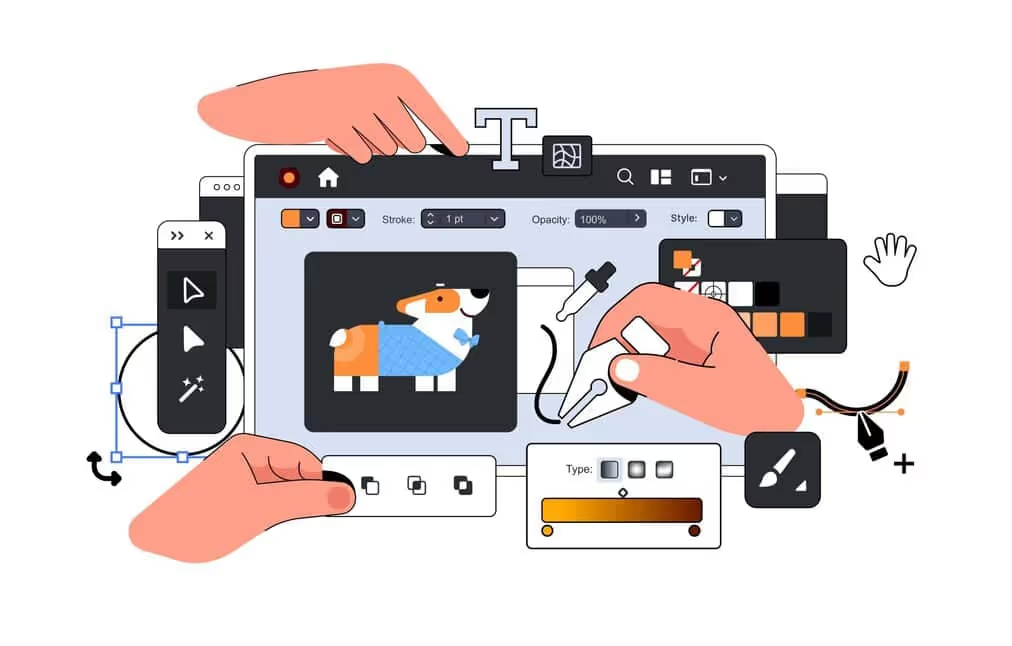From Web2 to Web3: How Web3 in Web Design Is Redefining Online Ownership
See how web3 in web design blends blockchain, wallets, and UX to create secure, decentralized, user-first digital experiences.

The digital illustration occurred in the mid-20th century, in the early days of computers and digital technology. However, its growth accelerated in the late 20th century when digital illustration tools became more accessible and widely used. Today, with the increasing development of digital devices, the works of illustrations have also grown considerably. But, to what extent do you understand these digitally produced illustrations?

Digital illustration, also known as computer illustration, is a form of visual communication. It uses digital tools to create images and visual arts that involve digital devices, such as graphic tablets, styluses, and software programs. The use of this digital product is usually in print, web, or multimedia projects.
Although the process uses digital devices and programs, some techniques still follow conventional methods. You still can draw or paint like you do on paper or canvas. The difference is that you can get some advantages from the digital tools you use. Adobe Illustrator, CorelDRAW, Procreate, and Adobe Photoshop are some software programs that will help create digital illustrators for their jobs.
The appearance of digital illustrations is different from traditional illustrations, which is its characteristic that makes it unique. However, more than just its appearance, computer-generated illustration has other features that make it more popular and prominent. Here they are.
When illustrators work the illustration traditionally, they will have some limitations on styles based on their tools. It won’t happen when you work on a digital one. Software programs for digital creations allow artists/illustrators to work in various styles. Experiment with different brushes, effects, and textures for unique and diverse results.
Working digitally is more efficient since the artists can make quick iterations and experimentation. Try different color schemes, refine details, and many more. You can do all without needing to start over from scratch.
Today’s technology and innovation allow us to collaborate on a project in real-time, no matter where you and your team are. It is useful especially when working on consecutive projects that need great teamwork, such as animation, game design, or graphic design.
Did you make an inaccurate brush stroke or apply the wrong color? You can just undo and redo the actions. These functions provide more control over the creative process and reduce the fear of making irreversible mistakes.
Brushes, pencils, pens, paints, and chalk are what traditional illustrators usually use in their works. However, you will find more tools to create your own work. Not only tools and features to draw and paint, but you also will find tools to manipulate images. Image manipulators, such as filters and transformation tools, can enhance creative possibilities.
Distributing digital illustrations is easier since you don’t need physical reproduction to share them with global audiences. They can be easily shared online. It also affects the effectiveness of publication times and overall project work.
The result of digital creation might look more flawless than the traditional one. However, if you save it in the wrong format, your illustrations may not be usable. There are also cases where the results are not good and are broken when printed. Here are some common formats for digital illustration to get the best result for the project.
You may find this format commonly in photographs. Even so, it is suitable for web graphics. Since it is a compressed format, it reduces the file sizes and, at the same time, may result in the loss of some quality. Therefore, it is not suitable for illustrations with sharp edges or text.
Keep the illustration quality by saving it in PNG format. That is why it is suitable for sharp edges illustrations and text. This format is commonly used for web graphics, illustrations, and images that require transparency.
Just like PNG, GIF uses lossless compression. However, it has a limited color palette, up to 256 colors. Hence, it is suitable for simple graphics and animations only. This format may support transparency, but it is limited to one color being fully transparent.
TIFF is a flexible saving format for preserving image quality since it can support lossless and lossless compression. Print and professional environments usually use the format for its high-quality images. Plus, it supports transparency and layers.
Working in collaboration is easier when you save your work in PSD format. It retains layers and other editing features and is typically not compressed. Since it is a native format for Adobe Photoshop, it is best to use the software to open and edit the files.
If you work on vector illustrations, saving them in AI format is the best one. It is a native format from Adobe Illustrator. So, it will be best to use the software to work on AI files, just like PSDs. This format is not compressed and contains vector graphics, text, and other Illustrator-specific elements.
SVG is another format file that is suitable for vector graphics. What makes it different from AI is it is an XML-based vector image format that is inherently text-based and can be compressed. It is best used for vector graphics, scalable illustrations, and web design. Other qualities of this format are supporting transparency and resolution-independent.
Digital illustration has flourished, fueled by technological advancements. While rooted in traditional methods, its dynamic evolution is evident in versatile software use, efficient workflows, collaborative possibilities, and an extensive array of creative tools. Its landscape continues to captivate and redefine the boundaries of visual storytelling.